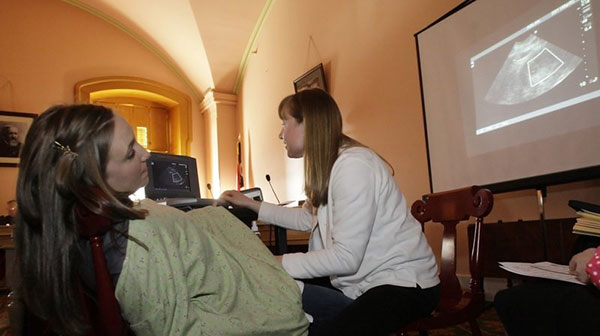
A fetus “testifies” in the Ohio legislature via ultrasound (From http://www.npr.org/2011/03/16/134425357/states-abortion-legislation-questioned-by-critics)
Later this week, I’ll be in Denver to participate in the Society for Social Studies of Science (4S) Annual Meeting. On Thursday (4:00 to 5:30pm, Denver Sheraton, Plaza Ballroom D), I will be presenting a paper co-authored with Jennifer Denbow that outlines some of our recent research on ultrasound. Our abstract reads:
Developments in ultrasound software continue to produce new representations of bodily interiors, profoundly influencing medical, popular, and political understandings of pregnant bodies. While numerous feminist STS studies have explicated the importance of the resultant images, none have examined how legal regulations and economic interests interact with software production to produce these images. In this paper, we examine the development of ultrasound software through interviews with computer programmers, technical documentation, academic articles, and federal regulations. We explore how three different academic ultrasound laboratories conceptualize their work in relation to regulatory frameworks. These three sites, and the researchers within, are part of complex assemblages that influence the design choices and assumptions that go into producing ultrasound software. Through an examination of the technical and regulatory frameworks, as well as the software that laboratories produce, we argue that the regulatory and economic structures affect what software is produced and thus what images are possible. Thus, we argue that the production and use of ultrasound software is co-constitutive with legal regulations, economic interests, and understandings of reproductive bodies.
I haven’t gone through the program closely yet, but someone pointed me to a panel titled “Make Kin Not Babies: Toward Feminist STS Pro-Kin and Non-Natalist Politics of Population and Environment,” which looks fantastic. It includes contributions from Donna Haraway, Adele E. Clarke, Michelle Murphy, Kim TallBear, Alondra Nelson, and Chia-Ling Wu (Thursday, November 12, 10:30am to 12:00pm, Denver Sheraton, Governor’s Square 15). The abstract reads:
Feminist STS scholarship has long and richly addressed biogenetic reproduction, focusing on race, region, sexuality, class, gender, and more. However, feminist STS has also largely been silent about reducing the human burden on earth while strengthening ecojustice for people and other critters as means and not ends. Can we develop anti-colonial, anti-imperialist, anti-racist, STS-informed feminist politics of peopling the earth in current times, when babies should be rare yet precious and real pro-family and community politics for young and old remain rare yet urgently needed? How can we develop collaborative politics recognizing that peoples subjected to (ongoing) genocides may need more children? How can we intervene in the relentless glut of attention devoted to problematic, costly “rights” and “needs” for (mainly richer) women to have babies as an individual “choice”?
Questions: How to nurture durable multi-generational non-biological kin-making, while humans everywhere transition to vastly less reproduction? What alternative ways of flourishing can be nurtured across generations and across cultures, religions, nations? How to deter on-going anti-feminist population control efforts while generating innovative discourses that legitimate non-natalist policies and choices? How to promote research on forms of contraception women and men want (and can use under diverse circumstances) and reproductive services that actually serve? How to build non-natalist kin-making technologies and sciences in housing, travel, urban design, food growing, environmental rehabilitation, etc.?
Where are the feminist utopian, collaborative, risky imaginings and actions for earthlings in a mortal, damaged, human-heavy world? Why hasn’t feminist STS taken the lead in such fundamental endeavors?





